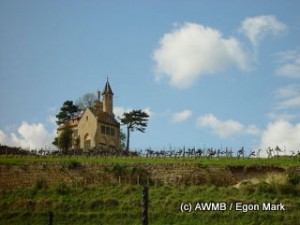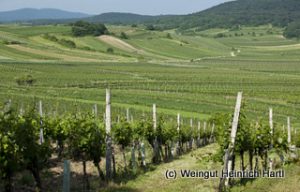Thermenregion reds

Thermenregion
Thermenregion is a region of two halves. The northern part, abutting Vienna, is home to white grape varieties rotgipfler and zierfandler, while the southern part, around Sooss, Tattendorf, Bad Vöslau and further south, is home to red pair pinot noir and saint laurent.
Underscoring this division, soils in the south are stony and gravelly rather than based on the limestone of the north.
Georg Schneider of Weingut Schneider introduced Thermenregion pinot noir during a seminar delivered at Vievinum in Vienna. He said “pinot noir is not a big player in Austria. There are about 650 hectares, less than 2% of the total vineyard area. There’s some along lake Neusiedl, but Thermenregion is the only region that puts a strong focus on this variety.”
Cistercian monks had brought pinot noir from Burgundy, establishing a winery at Freigut Thallern in Gumpoldskirchen in 1141.
Of the physical conditions Schneider said the southern vineyards “were flatter [than the north], with stone fields, chalk and a thin layer of brown earth. The climate is generally cool, with continental influences.”
Stylistically, he said “pinot noir in Thermenergion has a higher pH in comparison to Burgundy, with intense strawberry and raspberry fruit, and softer tannins.” Vinification is largely tradition, with open vats, punching down over two to three weeks and malolactic fermentation in small oak barrels. In terms of winemaking, he added “saint laurent needs more air – one or two more rackings.”

Thermenregion
At a tasting of Austria’s top 200 red wines from the 2009 vintage at Vievinum in 2012 (see later post), I rated pinot noir from Thermenregion as the most exciting.
Picking up the baton for saint laurent was Michael Reinisch of Weingut Johanneshof Reinisch who explained saint laurent is “a relative of pinot noir, though it has not yet been possible to find the other parent. Saint laurent has thicker skins than pinot noir, and the berries stick together so they can get rot. Sugar concentration never goes really high, we don’t get saint laurent wines with 14-14.5% alcohol.”
There are nearly 780 hectares of saint laurent in Austria, 20% of which are in Thermenregion.
Total pinot noir amounts to 650 hectares, 17% of which are in Thermenregion. More than half of all saint laurent and pinot noir is in neighbouring, bigger, Burgenland.
Tasting notes, from a seminar at Vievinum, Vienna, June 2012
Weingut A. Reinisch, Pinot Noir Reserve 2009
Tattendorf. 13%; 1.2 g/l RS; 5.1 g/l TA
Medium pale red, sandalwood aromas and toast. Attractive youthful strawberry nose, with strawberry and cream palate attack. Medium body, elegant, silky tannin attack, spicy tannin and supple sweet fruit. A calm wine, with some nice concentration and good length.
Weingut Schneider, Pinot Noir Reserve 2009
Tattendorf. 13.5%: 1 g/l RS; 4.8 g/l TA
Medium pale cherry red colour with nose of strawberry sprinkled with crushed black pepper. Supple, soft-stewed redcurrants and strawberries, with a silky texture and refined palate. Delicious supple, bright, warm fruit with good length.
Weingut Auer, Pinot Noir Reserve 2009
Tattendorf. 13.5%; 1 g/l RS; 5.1 g/l TA
Medium pale cherry colour. Ethereal strawberry and redcurrant flavours, with perfume building mid-palate. Fine, taffeta texture, really fine mouth-feel. Rich, delicately ripe red berry fruits, with freshness and warmth as hallmarks. Long finish. Very nice.
Weingut Heggenberger, Pinot Noir Reserve 2009
Tattendorf. 14%; 1g/l RS; 4.9 g/l TA
Medium pale colour. Hints of plum amid redcurrants and raspberries. Supple velvety texture, very smooth fruits, gentle, warming finish (not as in alcohol). Good.
Weingut Fischer, St. Laurent Classic 2009
Sooß. 12.5%; 1g/l RS; 5.1 g/l TA
Medium deep ruby red. Spicy with a bit of tar perfume. Medium body with dark forest berries and autumn hedgerow, fine-fine grain tannin, savoury liquorice note at the back palate. Fine, moreish flavour.
Weingut Dopler, St. Laurent Reserve 2009
Tattendorf. 13%; 4.5 g/l RS; 5.5 g/l TA
toasty, vanilla notes amid dark forest berries. Supple and sweet fruit with sweet tannins, soft fruits. Enticing mouthfeel. Dark fruits with fine-boned frame. Nice.
Stift Klosterneuburg, St. Laurent Reserve 2009
Tattendorf. 13.5%; 1g/l RS; 5.9 g/l TA
Meduim dark cherry colour. Spicy nose, more savoury than fruity. Wood-smoke, charcoal and plum fruits. Erring to foursquare.
Weingut Winzerhof Landauer-Gisperg, St. Laurent best of 2009
Tattendorf. 13%; 1g/l RS; 5.0 g/l TA
Medium dark cherry colour. Wafting smoke and dark cherry fruits. Medium body with fine-grain tannins, supple, dry-ripe fruits, plum, dark cherry, blackcurrant. Nicely balanced with attractive layering of flavour. Good.
Weingut Johanneshof Reinisch, St. Laurent Holzspur 2007
Tattendorf. 13.5%; 0.8 g/l RS; 5.2 g/l TA
Spicy with overt toastiness on the nose; dark, bass notes on the palate attack, rich and complex, with sophistication; layered dark spices and fresh leather, hint of raw meatiness. Textured, complex, long in-palate length and finish. Vg.
Comments
2 Responses to “Thermenregion reds”




August 3, 2012 at 5:15 pm
you omitted the best winemaker of the thermenregion: stadlmann, making wine since 1780. in addition to their fantastic zierfandlers & rotgipglers, they make an elegant, beautifully structured and delicious pinot noir.
August 5, 2012 at 10:22 am
Thanks Erika, for pointing this out. I didn’t select the wines for the seminar, I just wrote up my tasting notes. Stadlmann’s Zierfandler Mandel-Höh 2008 was shown in the white line-up in the same seminar though. http://www.winewisdom.com/articles/regional-profiles/thermenregion-whites/